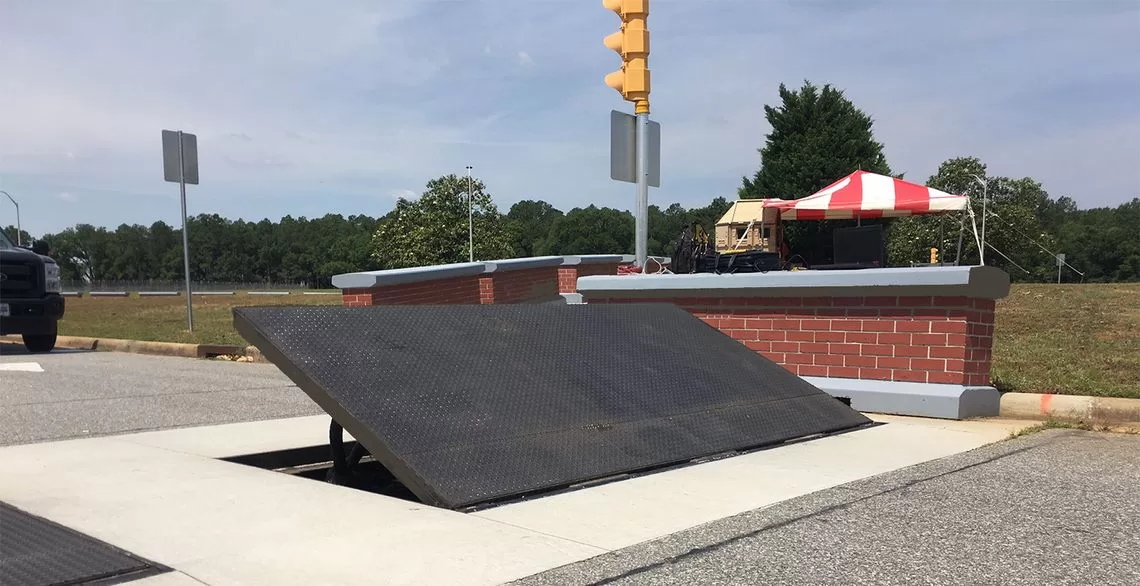Get This Report about Wedge Barriers

The Buzz on Wedge Barriers
The continuing to be pressure used to
the cam to deploy release wedge plate 16 may be provided by an electromechanical actuator 84 or other actuator. The springtime setting up 54 and the actuator 84(e. Wedge Barriers. g., electromechanical actuator)may operate together to translate the cam and raise the wedge plate 16.
As mentioned above, the spring setting up 54 exerts a continuous pressure on the webcam, while the electromechanical actuator may be managed to exert a variable force on the cam, thereby allowing the training and reducing( i. e., deploying and pulling back )of the wedge plate 16. In certain embodiments, the consistent force applied by the spring assembly 54 may be flexible. g., electromechanical actuator) is handicapped. As will be appreciated, the springtime assembly 54 may be covered and protected from debris or other aspects by a cover plate(e. g., cover plate 68 received FIG. 4) that may be substantially flush with the elevated surface area 38 of the structure 14. As pointed out over, in the deployed setting, the wedge plate 16 offers to obstruct gain access to or travel beyond the obstacle 10. The barrier 10(e. g., the wedge plate 16 )might obstruct pedestrians or lorries from accessing a residential or commercial property or pathway. As talked about over, the barrier 10 is affixed to the support 30 secured within the foundation 14,

front brackets 71. Therefore, the link assemblies 72 might pivot and revolve to make it possible for the collapse and extension of the link settings up 72 throughout retraction and implementation of the bather 10. The link settings up 72 reason activity of the wedge plate 16 to be restricted. For instance, if a car is traveling in the direction of the released wedge plate 16(e. For instance, in one scenario, the safety and security legs 86 may be expanded throughoutmaintenance of the barrier 10. When the safety and security legs 86 are deployed, the safety and security legs 86 sustain the weight of the wedge plate 16 versus the surface 12. Therefore, the training mechanism 50 may be deactivated, serviced, eliminated, changed, and so forth. FIG. 5 is partial perspective sight of an embodiment of the surface-mounted wedge-style barrier 10, highlighting the web cam 80 and the cam surfaces 82 of the training device 50. Particularly, 2 cam surface areas 82, which are described as reduced web cam surface areas 83, are positioned below the webcam 80. The reduced webcam surfaces 83 might be dealt with to the surface 12 (e. For example, the lower Continued camera surface areas 83 and the placing plate 85 may create a solitary piece that is protected to the support 30 by bolts or other mechanical fasteners. In addition, 2 camera surfaces 82, which are described as upper web cam surfaces 87, are positioned above the web cam 80 and coupled to (e. In various other personifications, stepping in layers or plates may be placed between the surface area 12 and the reduced web cam surface areas 83 and/or the wedge plate 16 and the upper cam surfaces 87 As pointed out above, the cam
80 converts along the webcam surfaces 82 when the wedge plate 16 is lifted from the withdrawed setting to the deployed placement. Additionally, as discussed above, the spring assembly 54 (see FIG. 3 )may supply a force acting upon the webcam 80 in the direction 102 by means of spring rod 58, which might decrease the force the electromechanical actuator 84 is called for to use to the cam 80 in order to actuate and lift the wedge plate 16. 1 )to the deployed setting(see FIG. 4). As shown, the cam 80 includes track wheels 104(e. g., rollers), which call and equate along the camera surface areas 82 during operation.